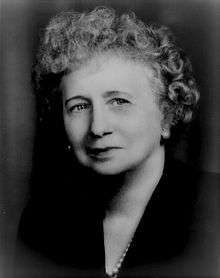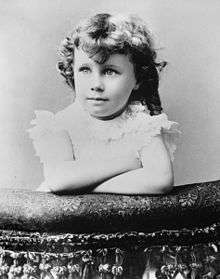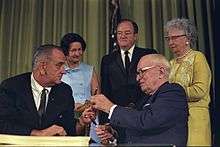Bess Truman
Elizabeth Virginia Truman (née Wallace; February 13, 1885 – October 18, 1982) was the wife of President Harry S. Truman and the First Lady of the United States from 1945 to 1953. She also served as the Second Lady of the United States in 1945.
Bess Truman | |
|---|---|
 | |
| First Lady of the United States | |
| In role April 12, 1945 – January 20, 1953 | |
| President | Harry S. Truman |
| Preceded by | Eleanor Roosevelt |
| Succeeded by | Mamie Eisenhower |
| Second Lady of the United States | |
| In role January 20, 1945 – April 12, 1945 | |
| Vice President | Harry S. Truman |
| Preceded by | Ilo Wallace |
| Succeeded by | Jane Barkley (1949) |
| Personal details | |
| Born | Elizabeth Virginia Wallace 13 February 1885 Independence, Missouri, U.S. |
| Died | 18 October 1982 (aged 97) Independence, Missouri, U.S. |
| Resting place | Harry S. Truman Presidential Library and Museum Independence, Missouri, U.S. |
| Political party | Democratic Party |
| Spouse(s) | |
| Children | Margaret |
| Signature | |
She had known her future husband since they were children attending the same school in Independence, Missouri. As First Lady, she did not enjoy the social and political scene in Washington, and at the end of her husband's term in 1953, she was relieved to return to Independence. She currently holds the record of longest-lived First Lady and longest-lived Second Lady, at 97 years, 247 days. She died in Independence, Missouri.
Early life and education

Bess Truman was born Elizabeth Virginia Wallace on February 13, 1885, to David Willock Wallace (June 15, 1860 – June 17, 1903) and his wife, the former Margaret Elizabeth Gates (August 4, 1862 – December 5, 1952), in Independence, Missouri, and was known as Bessie during her childhood. She was the eldest of four; three brothers: Frank Gates Wallace, (March 4, 1887 – August 12, 1960), George Porterfield Wallace, (May 1, 1892 – May 24, 1963), David Frederick Wallace, (January 7, 1900 – September 30, 1957). Bess had a reputation as a tomboy as a child.[1] As a young woman, Bess enjoyed expressing herself through her fashion and hats; a friend was quoted "Bess always had more stylish hats than the rest of us did, or she wore them with more style."[2]
Harry Truman met Bess soon after his family moved to Independence, and the two attended school together until graduation.[3]
After graduating from William Chrisman High School (then known as Independence High School) she studied at Miss Barstow's Finishing School for Girls in Kansas City, Missouri. In 1903, her father rose very early one morning, climbed into the family bathtub, and died by suicide by shooting himself in the head. According to biographer David McCullough, the cause for his suicide is unknown, with speculation ranging from depression to mounting debts.[4][5][6]
Bess and Harry Truman married on June 28, 1919, at Trinity Episcopal Church in Independence.[7] Harry courted Bess before he went off to fight during World War I; he proposed in 1911, but she turned him down. Truman later said that he intended to propose again, but when he did he wanted to be earning more money than a farmer did.[8] Their only daughter, Margaret, was born in 1924.[1]
Life in Washington
When Truman was elected as a Senator from Missouri in 1934, the family moved to Washington, DC. Mrs. Truman became a member of the Congressional Club, the PEO Sisterhood, the H Street United Service Organization, and the Red Cross work of the Senate Wives Club. She joined her husband's staff as a clerk, answering personal mail and editing committee reports when he became Chairman of the Senate Special Committee to Investigate the National Defense Program.[1]
First Lady of the United States
Bess found the White House's lack of privacy distasteful. As her husband put it later, she was "not especially interested" in the "formalities and pomp or the artificiality which, as we had learned..., inevitably surround the family of the President." Though she steadfastly fulfilled the social obligations of her position, she did only what she thought was necessary. When the White House was rebuilt during Truman's second term, the family lived in Blair House and kept their social life to a minimum. In most years of her husband's presidency, Mrs. Truman was not regularly present in Washington other than during the social season when her presence was expected.[9] The contrast with Bess's activist predecessor Eleanor Roosevelt was considerable. Unlike her, Bess held only one press conference after many requests from the media.[10] The press conference consisted of written questions in advance and the written replies were mostly monosyllabic along with many no comments.[11] When asked why she did not want to give press conferences she replied "I am not the one who is elected. I have nothing to say to the public."[2] Bess's response to whether she wanted her daughter Margaret to become President was "most definitely not." Her reply to what she wanted to do after her husband left office was "return to Independence".[12]
As First Lady, Bess served as Honorary President of the Girl Scouts, the Woman's National Democratic Club, and the Washington Animal Rescue League. She was Honorary Chairman of the American Red Cross.[1]
In 1953, the Trumans went back to Independence and the family home at 219 North Delaware Street, where the former president worked on building his library and writing his memoirs. Bess fully recovered following a 1959 mastectomy in which doctors removed a large, but benign, tumor.[13]
When President Lyndon Johnson signed Medicare into law in 1965, the Trumans were the first senior citizens to receive Medicare cards, presented to them by Johnson at the Truman Library.[14]

Antisemitism
In 1961, David Susskind conducted a series of interviews with former President Truman in Independence. After picking Truman up at his home to take him to the Truman Presidential Library for the interviews over several days, Susskind asked Truman why he had not been invited into the home. According to presidential historian Michael Beschloss, Truman flatly told Susskind, "This is Bess's house" and that there had never been nor would there ever be a Jewish guest in there.[15]
Widowhood, death and longevity record
At the time of her husband's death in 1972 at age 88, she was 87, making them the oldest couple having occupied the White House at that time. Bess agreed to be the honorary chairman for the reelection campaign of Sen. Thomas Eagleton (D-Missouri).[16]
Bess continued to live quietly in Independence for the last decade of her life, being visited by her daughter and grandchildren. She died on October 18, 1982, from congestive heart failure at the age of 97; a private funeral service was held on October 21. Afterwards, she was buried beside her husband in the courtyard of the Harry S. Truman Library in Independence, Missouri.[17]
Bess Truman remains the longest-lived First Lady and Second Lady in United States history.[16]
Notes
- "Truman: Bess Truman's Biography". www.trumanlibrary.org. Retrieved October 22, 2016.
- Geselbracht. "Young Bess in Hats" (PDF). Prologue. Spring 2013.
- Klapthor, Margaret Brown (October 1, 2002). The First Ladies. Government Printing Office. p. 75. ISBN 978-0-912308-83-8.
- American Experience: Truman PBS. 1997. Episode 1 of 2.
- "24,000 Pages of Bess Truman’s Family Papers Are Released". The New York Times/The Associated Press. February 14, 2009.
- "Bess Truman". Encyclopædia Britannica's Guide to American Presidents. Retrieved January 15, 2013.
- Margolies, Daniel S. (July 30, 2012). A Companion to Harry S. Truman. John Wiley & Sons. p. 37. ISBN 978-1-118-30075-6.
- McCullough, David (1992). Truman. New York: Simon & Schuster. pp. 78–79. ISBN 978-0-671-86920-5.
- Christensen, Lawrence O.; Foley, William E.; Kremer, Gary (October 1999). Dictionary of Missouri Biography. University of Missouri Press. p. 752. ISBN 978-0-8262-6016-1.
- Watson, Robert P. (2000). The Presidents' Wives: Reassessing the Office of First Lady. Lynne Rienner Publishers. p. 89. ISBN 978-1-55587-948-8.
- Burnes, Brian (November 1, 2003). Harry S. Truman: His Life and Times. Kansas City Star Books. p. 34. ISBN 978-0-9740009-3-0.
- Wertheimer, Molly Meijer (January 1, 2004). Inventing a Voice: The Rhetoric of American First Ladies of the Twentieth Century. Rowman & Littlefield. p. 212. ISBN 978-0-7425-2971-7.
- Neal, Steve (2004). Eleanor and Harry: The Correspondence of Eleanor Roosevelt and Harry S. Truman. Kensington Publishing Corporation. p. 259. ISBN 978-0-8065-2561-7.
- "President Johnson signs Medicare Bill on July 30, 1965". Politico. Retrieved December 15, 2013.
- Beschloss, Michael (2007). Presidential Courage: Brave Leaders and How They Changed America 1789–1989. New York: Simon & Schuster. p. 210. ISBN 0-684-85705-7.
- Algeo, Matthew (May 1, 2009). Harry Truman's Excellent Adventure: The True Story of a Great American Road Trip. Chicago Review Press. p. 226. ISBN 978-1-56976-251-6.
- "Bess Truman Buried - October 22, 1982". The Gettysburg Times. Retrieved August 1, 2013.
Notes
- Original text based on the White House biography
External links
| Wikimedia Commons has media related to Bess Truman. |
- D C McJonathan-Swarm (Jan 21, 2001). "Bess Truman". First Lady. Find a Grave. Retrieved August 18, 2011.
- Bess Truman at C-SPAN's First Ladies: Influence & Image
- Young Bess in Hats
- Biography
| Honorary titles | ||
|---|---|---|
| Preceded by Ilo Wallace |
Second Lady of the United States 1945 |
Vacant Title next held by Jane Barkley |
| Preceded by Eleanor Roosevelt |
First Lady of the United States 1945–1953 |
Succeeded by Mamie Eisenhower |
